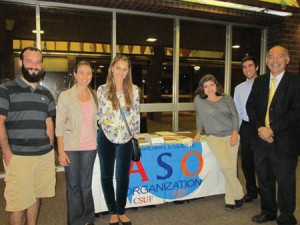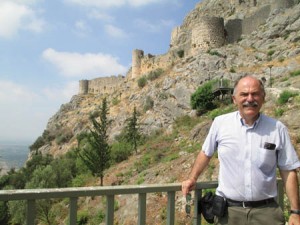Tamar Melkonian
Staff Writer

Have you ever wondered what a trip to historic Armenia would be like? On Friday, September 27, 2013, Professor Barlow Der Mugrdechian, Coordinator of the Armenian Studies Program, shared a presentation on his summer trip to historic Armenia.
Titled “Historic Armenia II: Armenian Cilicia,” this event was part two in a series by Der Mugrdechian, following a lecture about his first trip to historic Armenia in 2012. All eyes focused on the images shared in the presentation, which highlighted all of the beautiful historic sites that Professor Der Mugrdechian visited.
Der Mugrdechian’s trip was centered on Armenian Cilicia, but also included a variety of other cities that he visited in the first five days of his trip: Kars, Ani, Van, Bitlis, Moush, Dickranagerd (Diyarbekir), and more. In eleven days, Professor Der Mugrdechian’s group traveled more than 3,000 miles. While showing photos from Aintab, he also described some of the meals he enjoyed there: lahmajoon and pistachio paklava, which sparked an enormous reaction from the audience, as the foods were familiar to those prepared by Armenians with roots in Western Armenia.
Professor Der Mugrdechian then went into more detail about two main fortresses of the Armenian Kingdom of Cilicia (12th-14th century). He shared photos and his experiences at Hromkla, which was the spiritual headquarters of the Armenian Church from 1149-1292A.D. and was also the home to Catholicos St. Nerses the Graceful and the noted artist Toros Roslin. Roslin was known for his use of rich colors and beautiful detail seen in manuscripts executed during the period of the Cilician Kingdom.
The second fortress was that of Sis, the capital of the Armenian Kingdom of Cilicia and also significant as the site of the Armenian Catholicosate until the time of the Armenian Genocide.

Professor Der Mugrdechian and his group then traveled to the island castle of Korikos, along the Mediterranean Sea. Stops in Adana and Tarsus gave testimony to the Armenian history of the region.
The remnants of the once vibrant Armenian communities were embodied in the Armenian churches that remained.
He later visited Vakif, in the region of Musa Dagh, which is the only remaining Armenian village in Turkey.
Professor Der Mugrdechian presented images of Armenian churches that had been intentionally destroyed, as well photos of the Armenian quarter of Moush, which is currently being razed. Many people were moved by the photos.
In contrast to this destruction, Professor Der Mugrdechian explained that in some areas Armenian churches are being renovated with the permission of the government, such as St. Giragos in Dickranagerd and Holy Trinity in Malatia.
The lecture concluded with a question and answer session that included many asking about the possibility of re-appropriation of Armenian property and churches. This was sparked by all the images highlighting the changes in Turkey. Professor Der Mugrdechian explained that it would be a lengthy process to attain property, requiring Turkish acknowledgement of the Armenian Genocide, and also opening the legal case in Turkey.
A large audience was in attendance and it was great to see people being so engaged. Many appreciated Prof. Der Mugrdechian’s presentation and thanked him for taking the time to connect cultural history with today’s Armenians.
 Hye Sharzhoom Armenian Action
Hye Sharzhoom Armenian Action